Let's continue to consider the stamps from the series dedicated to Russian geographical expeditions. Today, the next step is the history of exploration of the islands of Novaya Zemlya, undertaken by the expedition led by Fyodor Petrovich Litke in 1821, 1822, 1823 and 1824.
Articles about previous stamps of the series -,.
Fyodor Petrovich Litke
Fyodor Petrovich Litke belonged to a glorious galaxy of sailors, immigrants from the Baltic Germans. His grandfather Ivan Filippovich Litke (Johann Philipp Litke) came to Petersburg in 1735. He was a learned theologian, a Lutheran pastor. Fyodor Petrovich's father, Pyotr Ivanovich Litke, was a military man, took part in the battles of Larga and Cahul in the Russian-Turkish war of 1768-1774. and served as adjutant to Prince N.V. Repnin.
Fedor was born in St. Petersburg on September 17 (September 28), 1797. During childbirth, his mother dies. In his autobiography, Fyodor Petrovich writes:
... the first and most unfortunate hour of my life was approaching. On September 17, 1797, I became the murderer of my mother. She survived my appearance in the world no more than two hours ...
The father remarried, but the marriage was unsuccessful. The new young wife poisoned his last years of life, and the children became an evil, cruel stepmother. When Fedor was 10 years old, his father also dies, the boy remains an orphan. No one was involved in his education, and throughout the difficult and dangerous time of his youth, Fedor was left to himself. Only thanks to the firmness of character and curiosity did he not disappear, he himself was engaged in his education, he read a lot. And it is not known how the fate of the future admiral would have developed if the husband of Natalya's older sister, Lieutenant Commander of the Navy I.S., had not paid attention to him. Sulmenev. Their mutual long conversations about the sea, ship life carried away the boy and, at the request of Sulmenev, in 1812 Fyodor Litke entered the fleet under his command. During his service in 1813, Litke participated in the siege of Danzig, where he distinguished himself, was promoted to midshipman and awarded the Order of Anna, 4th degree.
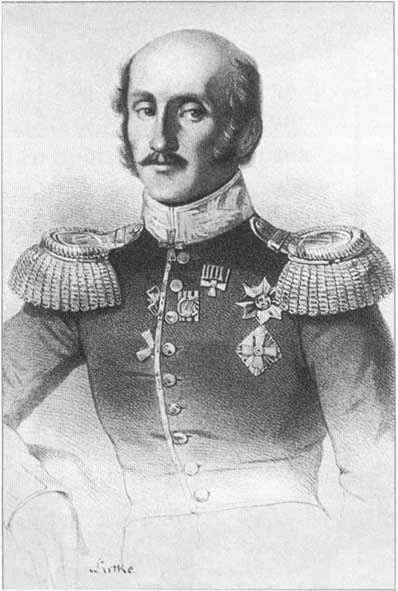
In 1817, Fyodor Litke was assigned to the Kamchatka sloop, setting off on a round-the-world voyage under command. On this journey, Fedor Petrovich gains invaluable experience, from a young midshipman he turns into an experienced naval commander. On this voyage, Litke became close to another future great traveler, Ferdinand Wrangel, whose friendship lasted a lifetime.
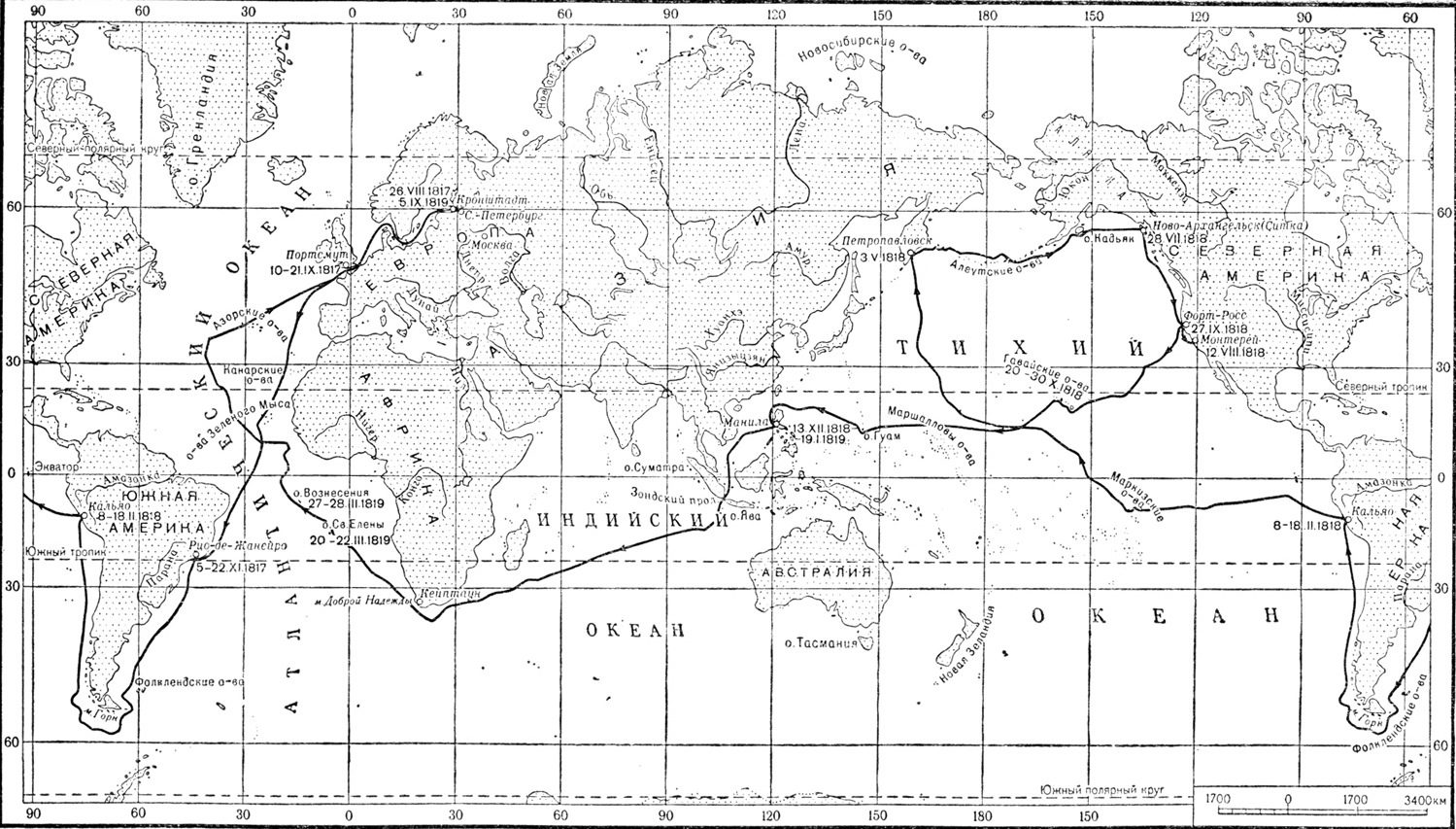 Circumnavigation by V.M. Golovnin on "Kamchatka" (1817-1819)
Circumnavigation by V.M. Golovnin on "Kamchatka" (1817-1819) V.M. Golovnin highly appreciated the professional and personal qualities of Litke and, upon his return, recommended Fyodor Petrovich to lead the expedition to explore Novaya Zemlya. At that time, Novaya Zemlya remained virtually terra incognita. Since the voyages of Barents in 1594-1597 and Rozmyslov in 1768-1769. serious studies of those places have not been undertaken. Maps of Novaya Zemlya and surrounding lands were very primitive.
The Arctic Ocean attracted navigators with the possibility of a shorter route from the Atlantic Ocean to the Pacific, to China and further to rich eastern countries. The vast Novaya Zemlya archipelago just lay in the path of these voyages, against which there was the very harsh northern weather and ice. One of the first European expeditions to find the northeast passage was the voyage in 1553 of the English flotilla, consisting of three ships under the command of Hugh Willoughby. The ships crossed the North Sea and moved further north. During one of the storms, one of the ships under the command of Captain Chancellor fell behind. In September, the two remaining ships anchored at the mouth of the Varzina River (Kola Peninsula). Wintering ended tragically, all 70 members of the expedition died. They were found the following spring by the Lapps. Things from both ships were delivered to Kholmogory and, by order of the tsar, returned to the British, who had learned about the fate of the lost expedition. The stray Captain Chancellor, having taken refuge after parting with the admiral in Wardhouse, sailed again to the east, entered the White Sea and finally arrived at the western mouth of the Dvina River, to the Nikolsky Monastery. This marked the beginning of Russia's trade with England.
Dutch traveler William Barents in 1594-1597 tried three times to find the northeast passage. During the third expedition, he, along with his people, was forced to spend the winter on Novaya Zemlya. Shortly after the end of wintering and sailing from the islands, Barents died of scurvy. This expedition was the last Dutch attempt to find a northern route to Asia. The Barents Sea is named after William Barents.
It is clearly seen on old maps that even by the beginning of the 19th century, the eastern coast of Novaya Zemlya remained completely unknown to navigators and cartographers.
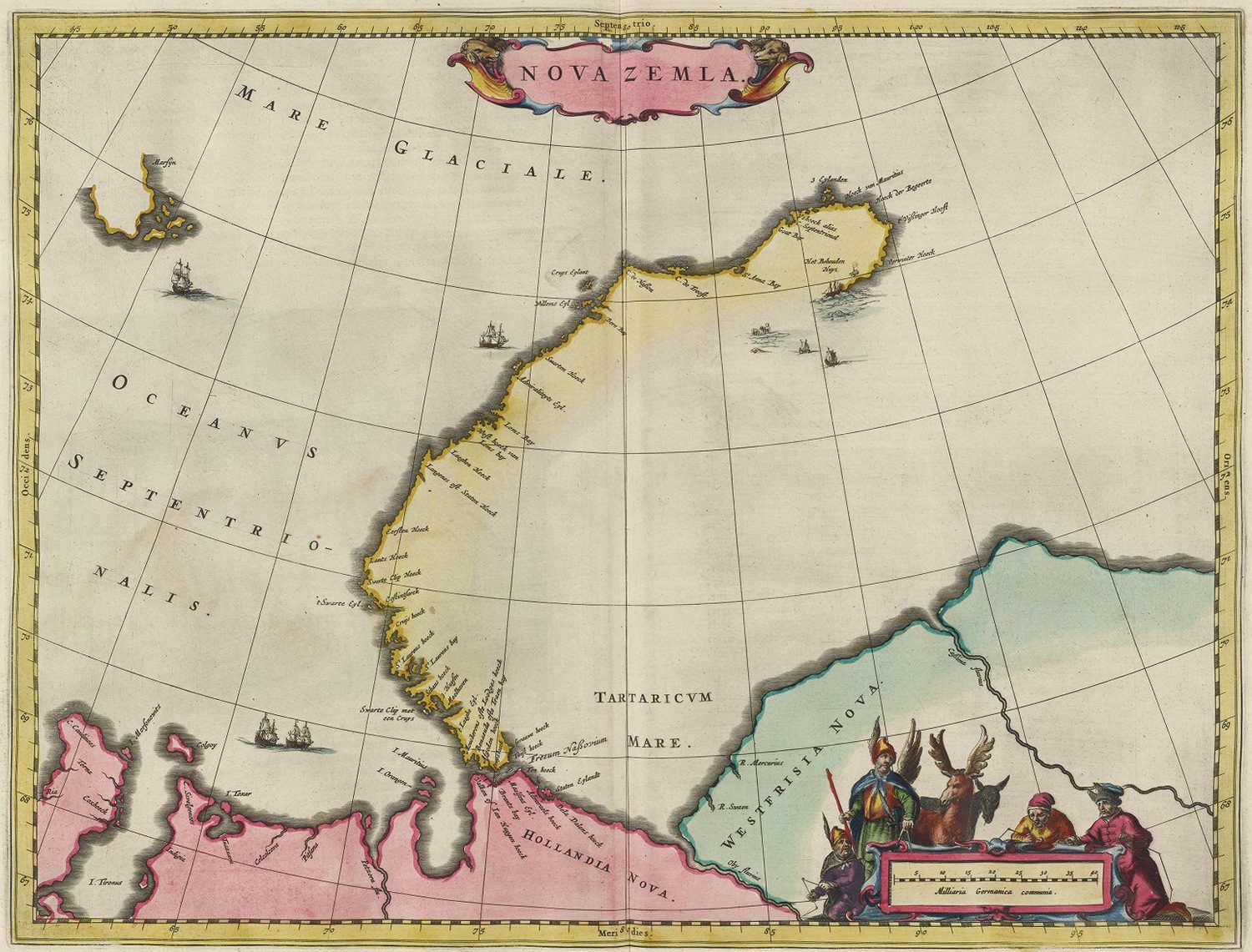 New Earth (Atlas Joan Blaeu, 1665) (Source: www.davidrumsey.com)
New Earth (Atlas Joan Blaeu, 1665) (Source: www.davidrumsey.com) 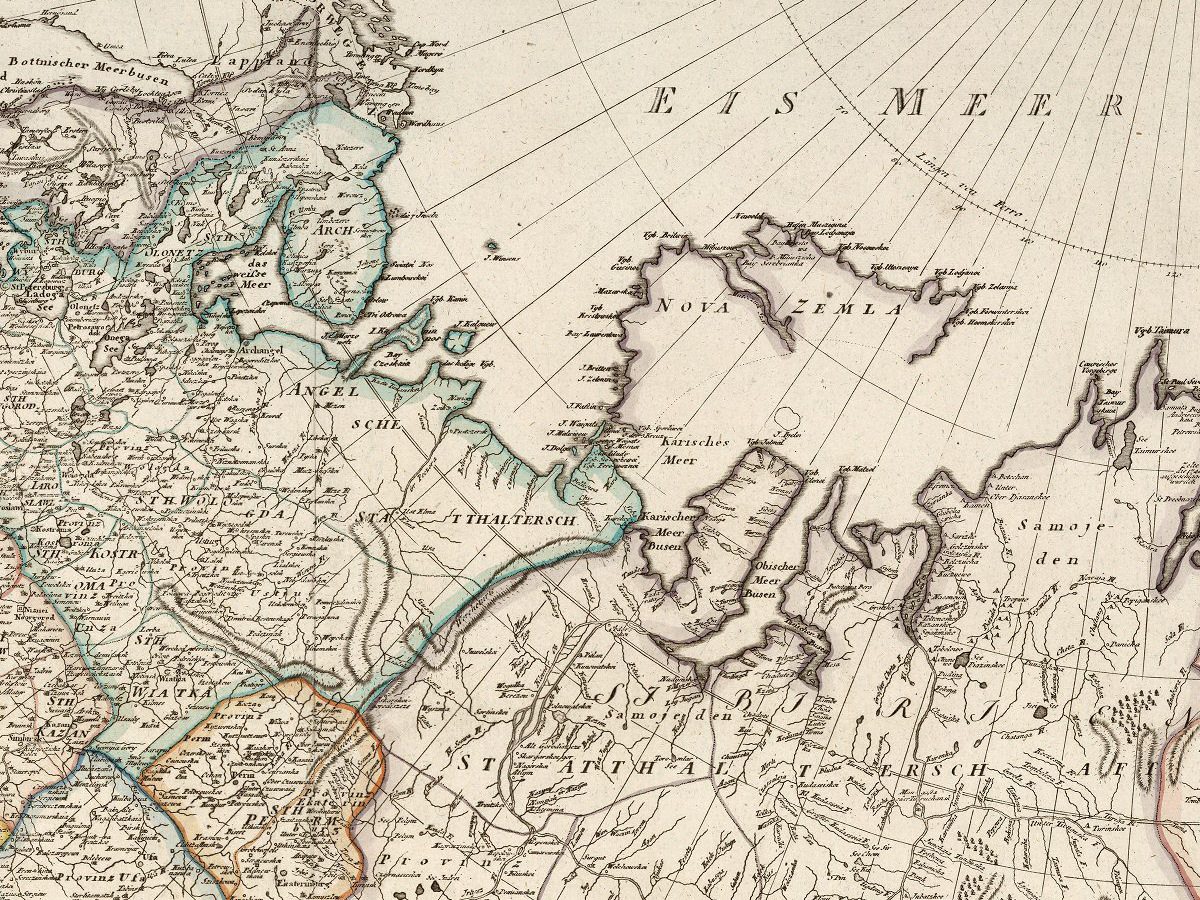 New Earth (Atlas Gaspari, 1817)
New Earth (Atlas Gaspari, 1817) The expedition of the navigator Rozmyslov in 1768-1769 was the first Russian scientific expedition equipped specifically for the study and inventory of Novaya Zemlya. She not only photographed Matochkina Shar (the strait between the North and South Islands), but also collected interesting information about the nature of the Novaya Zemlya Islands.
In 1819, a special expedition was created led by Lieutenant A.P. Lazarev. The instruction given to Lazarev set him the task of describing the whole of Novaya Zemlya and Vaigach Island in one summer, and in addition to determining the geographical coordinates of Kanin Nos and Kolguev Island. The scale of the tasks set, of course, did not correspond in any way with the real state of affairs and the possibilities of that time. And the expedition inevitably ended in complete failure. Lazarev never even landed on Novaya Zemlya and limited himself to sailing along the western shores. Some of the information he brought later turned out to be very erroneous. Upon returning to Arkhangelsk, it turned out that more than half of the team were sick with scurvy, and three died on the way.
Therefore, the instructions given to Litke were already much more careful. In particular, he was told:
The purpose of the assignment that is being made to you is not a detailed description of Novaya Zemlya, but the only survey for the first time of its shores and knowledge of the size of this island by determining the geographical position of its main capes and the length of the strait, called Matochkin's ball - if it is not prevented by ice or other important insanity
On July 27, 1821, an expedition of 43 people on the Novaya Zemlya brig left the port of Arkhangelsk and set off to the northeast. Food was stored for 16 months in case of unintentional wintering. On July 31, the expedition reached the shores of Novaya Zemlya, where the crew described the shores. The work of the first year was essentially only reconnaissance, during which Litke studied the conditions of navigation in the northern seas and tested the sea qualities of the ship. And the conditions were dangerous. On July 31, 1821, tacking north of the island of Morzhovets, the brig Novaya Zemlya ran aground, which has since been named after Litke. At the end of August, the brig headed back to Arkhangelsk, where it arrived on September 11th.
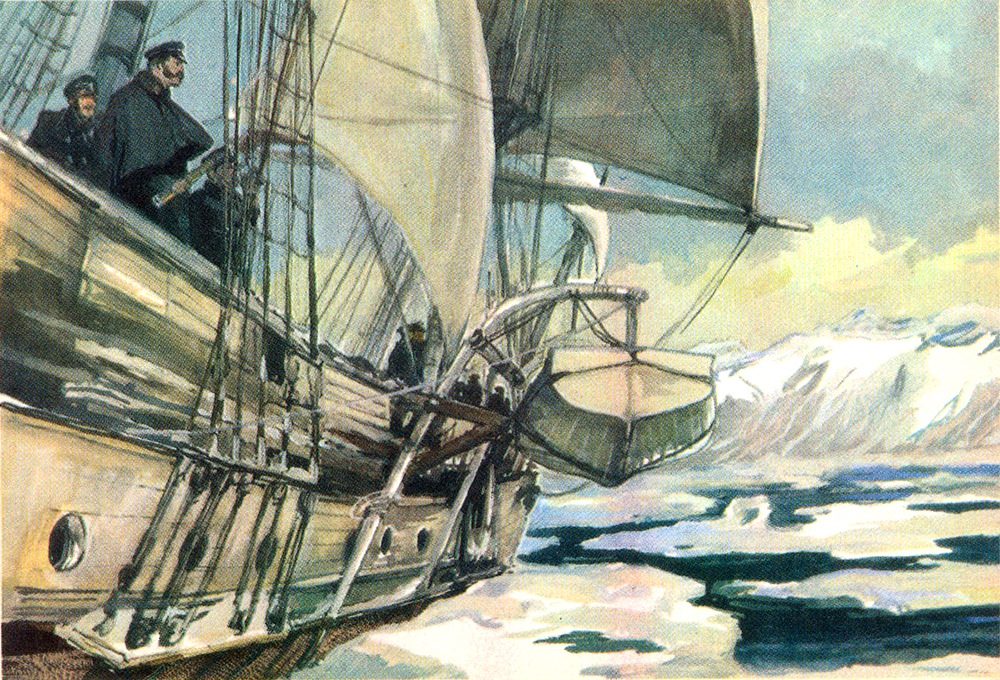 F.P. Litke off the coast of Novaya Zemlya. Artist P. Pavlinov
F.P. Litke off the coast of Novaya Zemlya. Artist P. Pavlinov The following year, from July 9 to August 17, Litke was engaged in exploring the coast near Murmansk and immediately after the completion of the work, he immediately went to Novaya Zemlya. During the expedition of 1822, the Matochkin Shar Strait was explored, its geographic coordinates were specified, and the coast to the southern Goose Nose was described. The storm that broke out forced them to stop work, and on September 12 they went to Arkhangelsk.
The success of the second year prompted the continuation of work in 1823. During the third expedition, the inventory of the Matochkin Shar Strait was completed. Rozmyslov's map turned out to be quite close to the truth. The length of the strait according to Rozmyslov differed from the determined Litka by three miles. From Matochkin Shara, Litke went south and on August 31 reached Kusovaya Zemlya, thus completing the inventory of the western coast of Novaya Zemlya to the southernmost tip. The Kara Gates were clear of ice. However, Litke, afraid of being pressed to the shore by ice and being forced to winter, did not go to the Kara Sea. Returning, the brig ran into a stone bank, the rudder was broken and the skin was torn off. When death seemed almost inevitable, a gust of wind pulled the ship off the shallows. Only the exceptional strength of Novaya Zemlya saved Litke and his companions from death. Thanks to the heroism and excellent training of the crew, the brig reached Solombala on September 12. Despite the accident, the progress of the third year was significant. In addition to describing the shores of Novaya Zemlya, Matochkin Shar, Kolguev Island and astronomical determinations, Litke made magnetic observations in several places. For this expedition, F.P. Litke was awarded on February 1, 1823 with the rank of lieutenant commander.
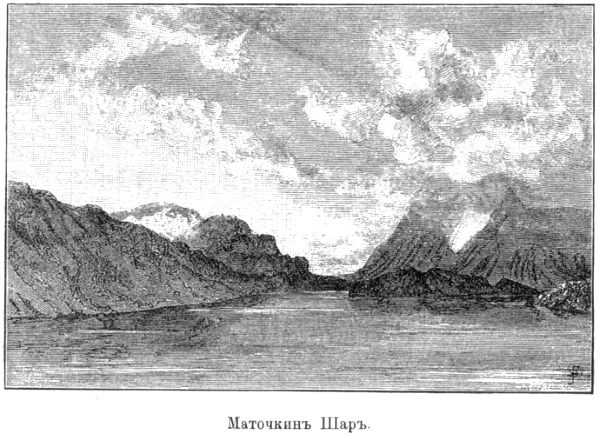
Evaluating the results of three years of work, Litke writes:
During the first three expeditions, apparently, everything that can be done off the coast of Novaya Zemlya on a seaworthy vessel equipped not for wintering was accomplished: the western and southern shores, as well as the Matochkin Strait, were described; a two-year attempt to penetrate to the northern coast was unsuccessful, due to solid ice in that direction; there was little hope of inspecting the eastern coast from a seagoing vessel because of the ice, which, according to all reports, almost never leaves that coast.
In 1824 an attempt was made to reach the east coast. However, solid ice prevented this and the successes of the fourth expedition were not great.
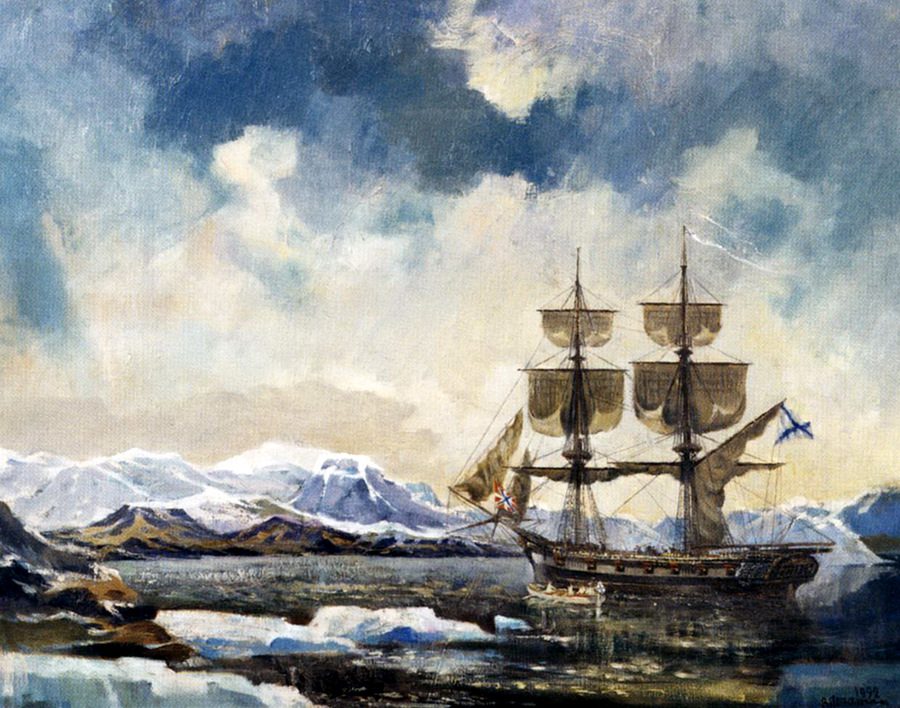 "Brig" Novaya Zemlya "under the command of F. P. Litke off the coast of Novaya Zemlya." Hood. Valentin Pechatin
"Brig" Novaya Zemlya "under the command of F. P. Litke off the coast of Novaya Zemlya." Hood. Valentin Pechatin At the end of the expedition, Litke began to process the collected materials and in 1826 completed his work “Four-fold trip to the Arctic Ocean, made on the Novaya Zemlya brig in 1821-1824”, which was subsequently translated into German by the famous naturalist Erman. In the preface to the German edition of the book, Ehrman wrote:
When photographing and describing all the points of the Arctic Ocean that he (Litke) reached, he so surpassed all his predecessors by the scientific thoroughness and impartiality of his judgments that these works cannot be passed in silence either in the history of navigation or in the history of geography.
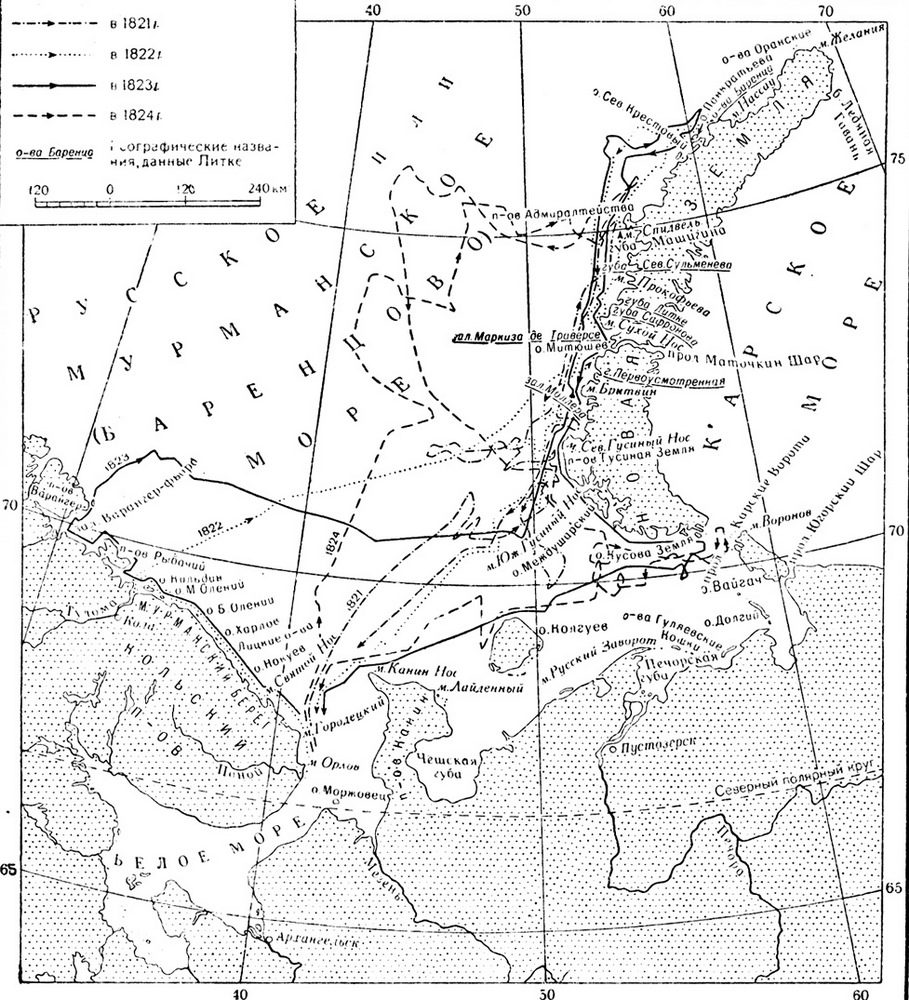 Sailing routes F.P. Litke to the shores of Novaya Zemlya in 1821-1824.
Sailing routes F.P. Litke to the shores of Novaya Zemlya in 1821-1824. As soon as Litke had time to finish his book, he was appointed commander of the Senyavin sloop, on which he set off on his second round-the-world voyage, which lasted from 1826 to 1829. But that's a completely different story.
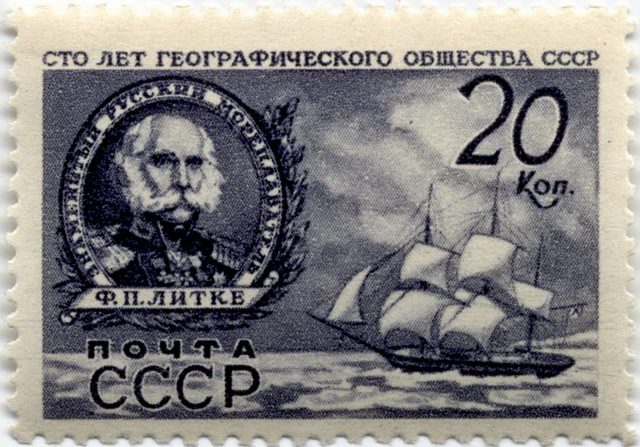 F. P. Litke (1797-1882). Sloop "Senyavin"
F. P. Litke (1797-1882). Sloop "Senyavin" USSR, 1947. Solovyov 1111, Mikhel 1089
The Finnish navigator Nils Nordenskiöld in 1878-1879 passed the first northeast route. True, his journey lasted two seasons - at the end of September 1878, his ship Vega froze into ice for 9 months just 195 km from the Bering Strait.
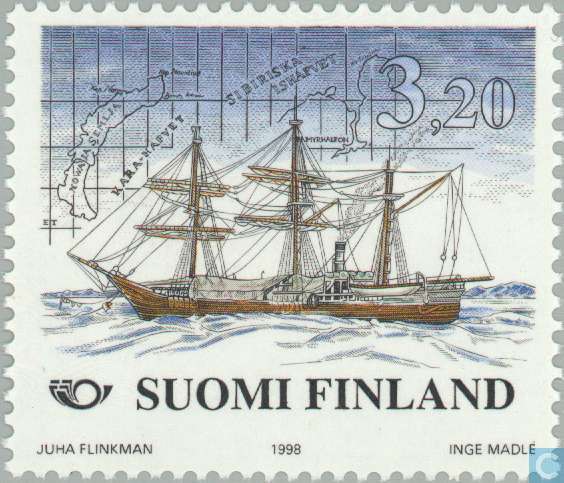 "Vega". Finland, 1996.
"Vega". Finland, 1996. Michel 1436 (not in the collection)
For the first time in one navigation, the icebreaker “A. Sibiryakov" in 1932, under the command of Captain Vladimir Ivanovich Voronin.
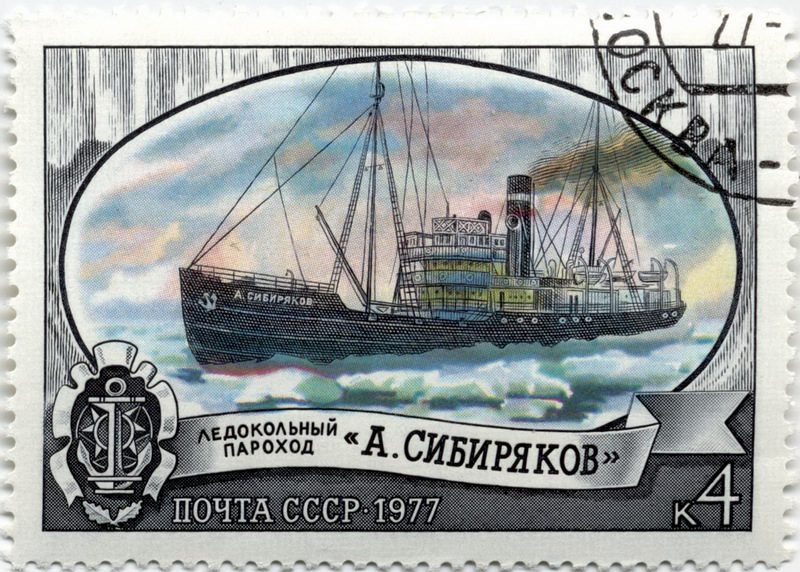 USSR, 1977
USSR, 1977 In honor of F.P. An icebreaker built in England in 1909 and bought by Russia during the First World War was also named Litke. On the icebreaker, or as it was then called the ice cutter “F.P. Litke" in 1934, for the first time in one navigation, a transition was made along the Northern Sea Route in the direction from east to west. The captain on that voyage was N. M. Nikolaev.
 USSR, 1977
USSR, 1977 And on Novaya Zemlya in the Soviet years, a range for testing atomic bombs was arranged. In particular, here on October 30, 1961, a 56 megaton Tsar bomb was exploded, an explosive seismic wave from which circled the globe three times.
Brig "New Earth"
The brig "Novaya Zemlya" was specially built for the Arctic expeditions at the Solombala shipyard, so it had reinforced skin. The builder is Andrey Mikhailovich Kurochkin, ship master of the 5th class. Laid down 4 December 1817, launched 10 July 1819
Specifications:
- displacement - 200 tons
- length - 24.4 m
- width - 6.1 m
- draft - 1.3 m
- board height - 2.8 m
- armament - 16 guns (during Arctic travels 6 3-pounder guns)
 Drawing of the brig "Novaya Zemlya" (
Drawing of the brig "Novaya Zemlya" (
